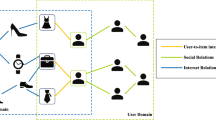Abstract
In recent years, more and more recommendation algorithms incorporate social information. However, most social recommendation algorithms often only consider the social homogeneity factor between users and do not consider the social influence factor. To make the recommendation model more in line with the real-life situation, this paper proposes a novel graph attention network to model the homogeneity effect and the influence effect in the user domain. Besides, we also extended this idea to the item domain, using information from similar items to alleviate the problem of data sparsity. Also, considering that there will be interactions between the user domain and the item domain, which together affect the user’s preference for the item, we use a contextual multi-armed bandit to weigh the interaction between the two domains. We have conducted extensive comparative experiments and ablation experiments on two real public datasets. The experimental results show that the performance of our proposed model in the rating prediction task is better than other social recommendation model.
Access this chapter
Tax calculation will be finalised at checkout
Purchases are for personal use only
Similar content being viewed by others
References
Huang, L.W., et al.: Survey on deep learning-based recommender systems. Chinese J. Comput. 41(7), 1619–1647 (2018)
Mcpherson, M., Lovin, L.S., Cook, J.M.: Birds of a feather: homophily in social networks. Ann. Rev. Sociol. 27(1), 415–444 (2001)
Marsden, P.V., Friedkin, N.E.: Network studies of social influence. Sociol. Methods Res. 22(1), 127–151 (1993)
Ma, H., Zhou, D., Liu, C., Lyu, M.R., King, I.: Recommender systems with social regularization. In: Proceeding of the 4th ACM International Conference on Web Search Data Mining, pp. 287–296 (2011)
Wang, X., He, X.N., Nie, L.Q., Chua, T.S.: Item silk road: Recommending items from information domains to social users. In: Proceeding of the 40th SIGIR Conference, pp. 185–194 (2017)
Jamali, M., Ester, M.: A matrix factorization technique with trust propagation for recommendation in social networks. In: Proceeding of the 4th ACM conference on Recommender systems(RecSys), pp.135–142 (2010)
Wen, Y.F., Guo, L., Chen, Z.M., Ma, J.: network embedding. based recommendation method in social networks. In: Proceeding of the 27th WWW Conference, pp. 11–12 (2018)
Liu, C.Y., Zhou, C., Wu, J., Hu, Y., Guo, L.: Social recommendation with an essential preference space. In: Proceeding of the 32rd AAAI Conference, pp. 346–353 (2018)
Wu, L., Sun, P., Hong, R., Fu, Y., Wang, X., Wang, M.: SocialGCN: an efficient graph convolutional network based model for social recommendation (2018). ar**v:1811.02815. https://arxiv.org/abs/1811.02815?context=cs.SI
Ying, R., He, R., Chen, K., Eksombatchai, P., Hamilton, W.L., Leskovec, J.: Graph convolutional neural networks for web-scale recommender systems. In: Proceeding of the 24th ACM SIGKDD International Conference on Knowledge Discovery & Data Mining (KDD), pp. 974–983 (2018)
Velikovi, P., et al.: Graph attention networks (2017). ar**v:1710.10903. https://arxiv.org/abs/1710.10903
Koren, Y.: Factorization meets the neighborhood: a multifaceted collaborative filtering model. In: Proceeding of the ACM SIGKDD International Conference on Knowledge Discovery Data Mining, pp. 426–434. ACM, New York, USA (2008)
He, X., Liao, L., Zhang, H., Nie, L., Hu, X., Chua, T.: Neural collaborative filtering. In: Proceeding of the 26th WWW Conference, pp. 173–182 (2017)
Tang, J., Gao, H., Liu, H.: mTrust: discerning multi-faceted trust in a connected world. In: Proceeding of the 5th ACM International Conference on the Web Search Data Mining, pp. 93–102 (2012)
Massa, P., Avesani, P.: Trust-aware recommender systems. In: Proceeding of the 1st ACM Conference on the Recommender System, pp. 17–21. Minneapolis (2007)
Guo, G., Zhang, J., Yorke-Smith, N.: TrustSVD: collaborative filtering with both the explicit and implicit influence of user trust and of item ratings. In: Proceeding of the 29th AAAI Conference on Artificial Intelligence, pp. 123–129 (2015)
Zhang, C., Yu, L.: Collaborative user network embedding for social recommender systems. In: Proceedings of the 17th SIAM International Conference on Data Mining (SDM), pp. 381–389 (2017)
Fan, W., Ma, Y., Li, Q., He, Y., Zhao, E., Tang, J., Yin, D.: Graph neural networks for social recommendation. In: Proceeding of the 28th WWW Conference, pp.417–426 (2019)
Wu, Q., et al.: Dual graph attention networks for deep latent representation of multifaceted social effects in recommender systems. In: Proceeding of the 28th WWW Conference, pp. 2091–2102 (2019)
Yang, L., et al.: ConsisRec: enhancing gnn for social recommendation via consistent neighbor aggregation. In: SIGIR 21: The 44th International ACM SIGIR Conference on Research and Development in Information Retrieval. ACM (2021)
Ma, H., Yang, H., Lyu, M.R., King, I.: SoRec: social recommendation using probabilistic matrix factorization. In: Proceeding of the CIKM, pp. 931–940 (2008)
Lin, T.-H., Gao, C., Li, Y.: Recommender systems with characterized social regularization. In: Proceeding of the 27th ACM International Conference on Information and Knowledge Management, pp. 1767–1770 (2018)
Rafailidis, D.: Leveraging Trust and Distrust in Recommender Systems via Deep Learning (2019). ar**v preprint, ar**v:1905.13612
Bahdanau, D., Cho, K., Bengio, Y.: Neural Machine Translation by Jointly Learning to Align and Translate (2014). ar**v preprint, ar**v:1409.0473
Author information
Authors and Affiliations
Editor information
Editors and Affiliations
Rights and permissions
Copyright information
© 2021 ICST Institute for Computer Sciences, Social Informatics and Telecommunications Engineering
About this paper
Cite this paper
Ying, W., Yu, Q., Wang, Z. (2021). Recommendation Model Based on Social Homogeneity Factor and Social Influence Factor. In: Gao, H., Wang, X. (eds) Collaborative Computing: Networking, Applications and Worksharing. CollaborateCom 2021. Lecture Notes of the Institute for Computer Sciences, Social Informatics and Telecommunications Engineering, vol 406. Springer, Cham. https://doi.org/10.1007/978-3-030-92635-9_6
Download citation
DOI: https://doi.org/10.1007/978-3-030-92635-9_6
Published:
Publisher Name: Springer, Cham
Print ISBN: 978-3-030-92634-2
Online ISBN: 978-3-030-92635-9
eBook Packages: Computer ScienceComputer Science (R0)




